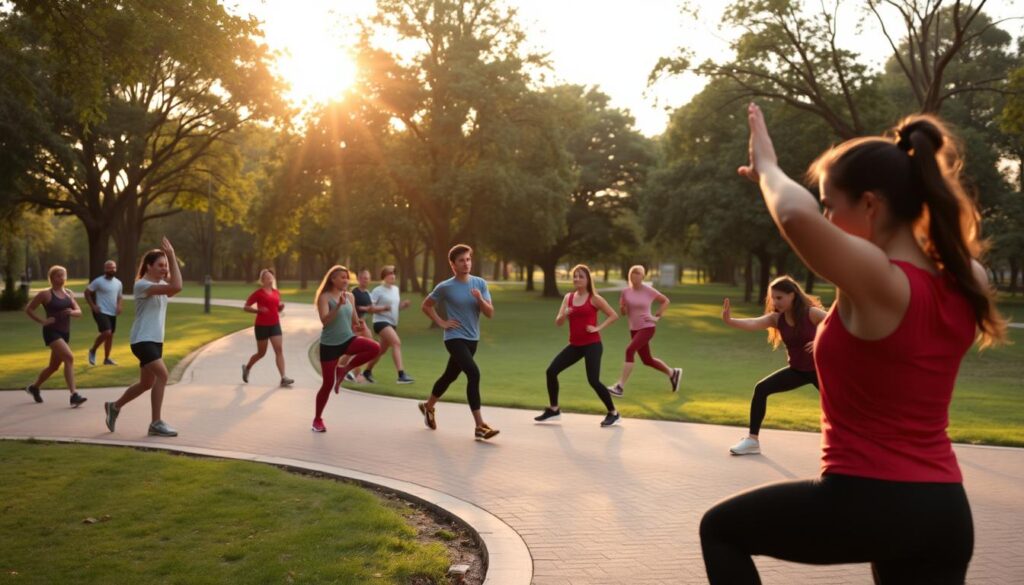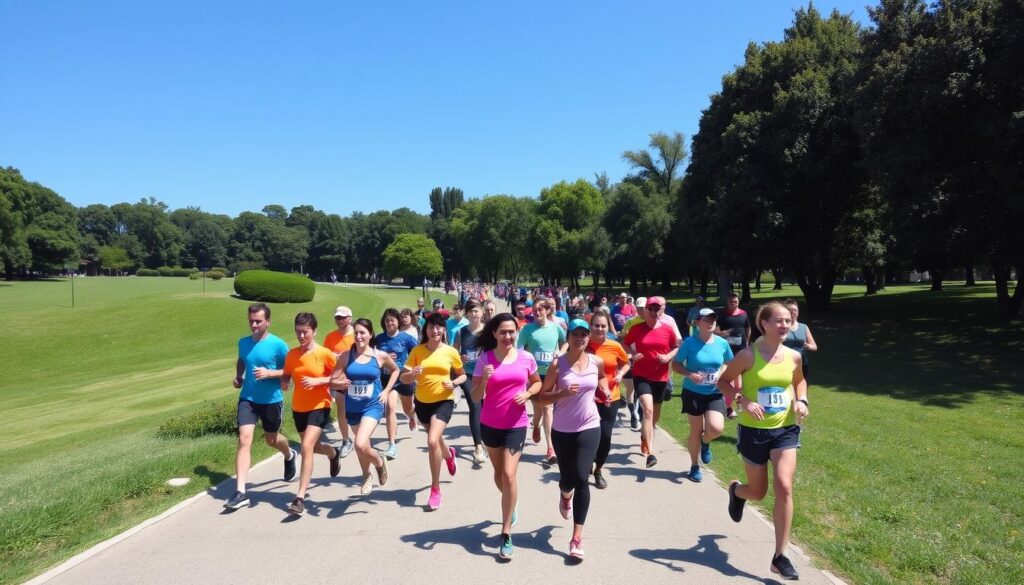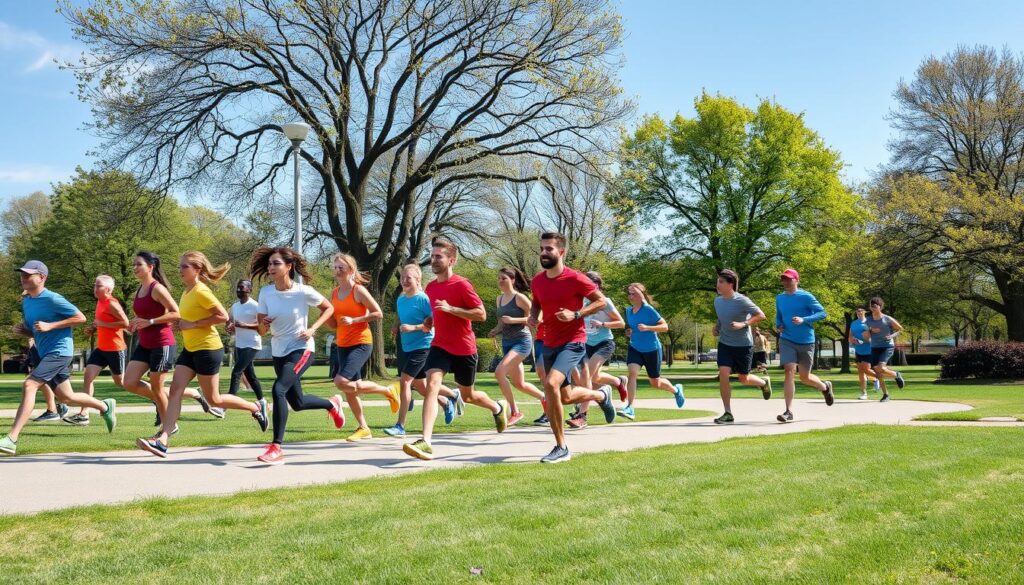Imagine the rhythm of your footsteps echoing in harmony with your heartbeat, each stride a step closer to improving your health and well-being. Jogging isn’t just a form of exercise; it’s a personal journey toward a healthier, happier you. Whether you’re just starting or looking to enhance your routine, this beginner jogging guide will introduce you to the transformative power of this simple yet profound activity. Consider this: not only does jogging offer remarkable health benefits, from boosting your physical fitness to improving your mental clarity, but it can also create a sense of community that uplifts your spirit. As you lace up your shoes, remember that every runner starts somewhere, and the path to your goals is just a few strides away.
Key Takeaways
- Jogging provides significant physical and mental health benefits.
- Lace up properly to prevent injuries and enhance your experience.
- Set realistic goals to keep motivated and on track.
- Consistency is key; engage with a community for support.
- Always incorporate warm-up and cool-down exercises.
Understanding the Benefits of Jogging
Jogging is more than just a physical activity; it is a pathway to enhanced health and well-being. Engaging in this form of outdoor exercise presents a range of health benefits that positively impact both your body and mind. You can find a fulfilling routine in jogging while discovering how it nurtures not only your fitness journey but also your social connections.
Physical Health Benefits
One of the most significant health benefits of jogging is its ability to enhance cardiovascular health. Maintaining a consistent pace below 6 mph effectively strengthens the heart, improves circulation, and supports overall fitness. Regular jogging helps in:
- Boosting weight loss more effectively than walking, enhancing your fitness goals.
- Reducing insulin resistance, making it a crucial exercise for individuals at risk of prediabetes.
- Increasing bone strength and muscle tone, thus promoting a healthier physique.
- Improving longevity, as indicated by studies showing that light, consistent jogging contributes to a longer life.
Mental Health Benefits
The mental health benefits of jogging are profound, contributing to emotional stability and stress reduction. Research indicates that jogging significantly decreases cortisol levels, making it a powerful tool against anxiety and depression. Regular participants in outdoor exercise have shown:
- Enhanced executive functioning, which plays a role in decision-making and cognitive abilities.
- Protection against cognitive decline associated with aging and stress.
- Improved mood regulation, attributed to the release of endorphins during exercise.
Social Benefits
Beyond the physical and mental advantages, jogging fosters social connections. Joining community running groups or participating in local events allows you to meet like-minded individuals who share similar fitness aspirations. The social benefits include:
- Creating a support network that encourages your fitness journey.
- Increased motivation through shared goals and experiences with others.
- Opportunities to participate in organized events, enhancing your enjoyment of outdoor exercise.
| Benefit Type | Specific Benefits |
|---|---|
| Physical Health | Cardiovascular health, weight loss, increased muscle tone |
| Mental Health | Stress reduction, improved mood, cognitive protection |
| Social Benefits | Support networks, motivation, community events |
Getting Started with Jogging
Beginning your jogging journey requires thoughtful preparation and planning. Choosing the right running gear is crucial for both comfort and safety, while setting realistic goals will keep you focused and motivated along the way.
Choosing the Right Gear
Investing in proper running gear can greatly enhance your jogging experience. The most important piece is a pair of well-fitted running shoes, tailored to your foot type and running style. Brands like Nike, ASICS, and Brooks offer a variety of options suited for different needs. Remember to replace your shoes regularly to prevent injuries. Beyond footwear, consider moisture-wicking clothing, which helps regulate your body temperature and keeps you comfortable.
Setting Realistic Goals
Establishing achievable goals is a key component of any beginner jogging guide. Start with an approach that gradually increases your distance or frequency. For example, if you’re new to jogging, you might aim for a mix of jogging and walking, beginning with intervals like 1 minute of running followed by 2 minutes of walking. Tracking your progress through fitness apps such as Strava can lend an element of motivation, allowing you to see how you improve over time.
Participating in community events like Parkruns can also serve as a great incentive. With over 2,000 Parkruns held across 22 countries, you’ll find that engaging with others fosters a supportive environment. This social aspect can be a game-changer for maintaining your commitment. Setting a target race three months out enables you to stick to a structured training plan tailored for beginners. A realistic goal will keep you grounded while promoting steady progress.

| Aspect | Suggestions |
|---|---|
| Running Gear | Invest in quality running shoes, moisture-wicking clothing, and safety gear like reflective vests. |
| Goal Setting | Start with interval training gradually increasing distance, consider community runs, and set time-bound goals. |
| Tracking Progress | Use fitness apps to monitor your jogging sessions and share your results with peers. |
Following these steps will lay a solid foundation for a successful jogging routine, maximizing both enjoyment and performance as you embark on your fitness journey.
Creating a Jogging Routine
Establishing a jogging routine serves as a vital stepping stone toward achieving your fitness goals. A consistent approach allows you to incorporate jogging into your daily life. Effective time management strategies play a crucial role in maintaining this routine. By reserving early mornings or utilizing breaks for your workouts, you can seamlessly integrate jogging into your schedule.
Time Management Tips
Efficient time management can significantly enhance your dedication to a jogging routine. Here are some practical tips:
- Identify specific days and times dedicated to jogging.
- Utilize a calendar or fitness app to track your sessions.
- Consider starting your day with a brief jog to boost energy and productivity.
- Employ the run/walk method, initially jogging for three minutes, followed by a one-minute walk, to ease into routine.
- For those who prefer a softer start, alternate two minutes of running with four minutes of walking.
Frequency and Duration
Finding an ideal balance in terms of frequency and duration can optimize your fitness journey. Beginners usually start with three days of jogging per week, gradually increasing to four days. Initial sessions should be around 20 minutes long, with a gradual increase of no more than 10 percent each week to reduce injury risks. After becoming comfortable with your sessions:
| Weeks | Initial Duration (minutes) | Target Duration (minutes) |
|---|---|---|
| 1 | 20 | 22 |
| 2 | 22 | 24 |
| 3 | 24 | 26 |
| 4 | 26 | 28 |
Incorporating such structured plans not only fosters discipline but also enhances your overall fitness level. Aim to achieve a comfortable level of endurance, progressively working toward your longer-term goals, such as preparing for a 5K or even a 10K. Your jogging routine should be designed to be sustainable, rewarding, and most importantly, enjoyable.

Warm-Up and Cool-Down Exercises
Emphasizing a proper warm-up and cool-down is essential for any jogging routine. These practices prepare your body for exercise and assist in recovery afterward, significantly enhancing your overall performance.
Importance of Warm-Up
A 5 to 10-minute warm-up is recommended to prepare your muscles for running. This phase gradually increases your heart rate and blood flow, allowing muscles to receive more oxygen. As blood vessels dilate, muscle temperature rises, improving flexibility. Professional runners universally advocate for this practice, noting that a thorough warm-up enhances muscle readiness and performance. Skipping this crucial step increases the risk of injury and hampers overall workout effectiveness.
Stretching Techniques
Incorporating effective stretching techniques during your warm-up can boost performance. Dynamic stretching is preferred as it promotes muscle activation without the drawbacks of static stretching, which should be reserved for post-running. Recommended durations are 10 to 15 seconds for each stretch, concentrating on key muscle groups such as your hips, glutes, ankles, and calves. Plyometric exercises can further enhance speed and strength, forming a beneficial part of your warm-up routine.
Post-Jogging Cool-Down
A proper cool-down is just as important, helping your body transition back to a resting state. Aim for a walking cool-down lasting 5 to 10 minutes to prevent light-headedness and allow your heart rate to decrease gradually. This process reduces muscle contraction and averts blood pooling in the lower body. Following your run, static stretches targeting major muscle groups alleviate tightness. Foam rolling is an additional technique some runners utilize for enhancing circulation and supporting recovery. Timely post-run refueling with protein, carbohydrates, and hydration optimizes muscle recovery and replenishes glycogen stores.

Finding the Perfect Jogging Location
Choosing the right jogging location plays a crucial role in enhancing your outdoor exercise experience. Quality jogging locations not only cater to your fitness level and goals but also influence your motivation and enjoyment. A refreshing atmosphere can make all the difference, especially if you often find yourself lacking the drive to jog. Understanding your options can help you select a place that makes each run more enjoyable.
Parks and Trails
Parks and trails stand out as excellent choices for park jogging, providing natural beauty and tranquility. They often feature varied terrains, which can improve endurance and motivate you to explore new routes. Safety is essential, and parks usually have minimal traffic, reducing the risk of accidents. A well-maintained trail can ensure that your running surface is smooth, lowering the chances of injury compared to uneven terrain.

Urban vs. Rural Environments
Urban environments offer convenience and accessibility, which can be beneficial for busy lifestyles. On the other hand, rural settings provide peace and stunning views, ideal for those who seek a more serene outdoor exercise experience. When selecting between these two, consider factors like safety, distance to amenities, and personal preference. Urban areas may have higher traffic, but they also boast extensive parks where you can enjoy jogs safely. Regardless of where you choose to run, varying your routes can keep your routine fresh and engaging.
Staying Motivated on Your Jogging Journey
Maintaining motivation throughout your jogging journey can be a challenge. Setting realistic milestones and engaging with a jogging community can significantly enhance your experience and keep you focused on achieving your fitness goals.
Setting Milestones
Breaking your fitness goals into smaller, achievable milestones can have a positive impact on your motivation. Studies show that participants who set realistic goals experience a 65% higher success rate in reaching their running objectives. This approach not only reinforces your commitment but also provides a sense of accomplishment as you progress. Consider tracking your milestones with a journal or a fitness app to visualize your achievements.
Joining a Community
Being part of a jogging community can greatly enhance your motivation. Group running is a fantastic way to stay accountable and receive encouragement from others. Research reveals that runners who engage with a community are 36% more likely to maintain their jogging routines after the first year. You might find joy in sharing experiences, participating in group events, or simply enjoying the company of fellow runners. This social engagement can play a vital role in keeping your enthusiasm high.

Incorporating Interval Training
Enhancing your jogging routine can be easily achieved by incorporating interval training. This method, which involves alternating between high-intensity jogging and recovery periods, is effective for improving cardiovascular fitness and speed. Many find that integrating interval training into their cardio workout not only boosts performance but also keeps their workouts engaging.
What is Interval Training?
Interval training consists of bursts of intense effort mixed with intervals of active recovery. For beginners, it is best to start with one session of interval training per week. This approach helps prevent muscle overload while allowing for gradual improvements. As you progress, increasing your frequency to two or three sessions a week is beneficial.
Benefits of Interval Training
Engaging in interval training can lead to numerous benefits, including:
- Improved cardiorespiratory fitness, as supported by recent studies that show high-intensity interval training (HIIT) is more effective than medium-intensity workouts.
- Enhanced speed and performance, particularly beneficial for those training for races.
- Greater calorie burn, which helps in weight management.
A simple beginner session can include 4-6 repetitions of 1 minute of fast jogging, followed by 2 minutes of recovery. As you gain experience, consider incorporating more complex interval distances ranging from 400 to 600 meters.
| Interval Type | Duration (Minutes) | Intensity (RPE) | Recovery Duration (Minutes) |
|---|---|---|---|
| Short Intervals | 0.5 – 1 | 8-9 | 2 |
| Long Intervals | 2 | 6-7 | 2-3 |
| Pyramid Intervals | 1 – 4 | 6-9 | 1-2 |

By integrating these jogging techniques into your routine, you can experience significant improvements in your cardio workout while enjoying a dynamic and effective training method. Stay consistent and gradually increase your intensity for the best results. Happy jogging!
Running Techniques for Beginners
As you embark on your jogging journey, mastering running techniques becomes crucial for both enjoyment and safety. By prioritizing proper form and posture, you can significantly reduce the risk of injury while enhancing your overall performance. Below are essential aspects to focus on for optimal running experience.
Proper Form and Posture
To adopt the right running techniques, begin by maintaining an upright posture. Here are some key components to consider:
- Relaxed shoulders: Tension in your shoulders can hinder fluid movement.
- Foot strike: Aim for a light forefoot or mid-foot strike to conserve energy and lower injury risk.
- Engage your glutes and hamstrings: This promotes better leg control and mimics the pedal dynamics in cycling.
- Arm movement: Efficient arm swings can influence your forward momentum. Incorrect movements lead to wasted energy.
Breathing Techniques
Effective breathing plays a pivotal role in your stamina during runs. Some practical methods include:
- Run at a conversational pace: This allows for easier oxygen intake.
- Segmentation: Try the “30-minute run” strategy, segmenting your run into 4-minute intervals with focus on form in the last minute.
- Awareness of posture: Regularly check your form and breathing patterns for immediate improvements.
Integrating these running techniques will create a solid foundation for your jogging experience. With regular practice, you will notice enhancements in performance and a reduction in injury risks.

Nutrition Tips for Joggers
Understanding proper nutrition and hydration is vital for optimizing your jogging experience. Consuming the right pre-jogging snacks helps fuel your body, while effective hydration strategies keep you hydrated during your runs. Focus on these elements as part of your jogging tips to enhance your performance and overall experience.
Pre-Jogging Snacks
Eating a carb-rich snack about 30 minutes before jogging can provide the necessary energy boost. Aim for snacks that are low in fiber and fat to prevent gastrointestinal issues. Options include:
- Bananas
- Granola bars
- Rice cakes with honey
- Toast with jam
Distance runners may benefit from carb-loading before significant events to maximize glycogen stores. A balanced post-run meal containing complex carbohydrates and protein will aid recovery and replenish energy levels.
Hydration Strategies
Staying well-hydrated is crucial for maintaining performance and avoiding dehydration. As a general guideline, drink about half your body weight in ounces daily. For example, if you weigh 150 pounds, aim for around 75 ounces of water. For runs longer than 60 minutes, consider consuming 30-60 grams of carbohydrates per hour mixed with fluid to maintain energy and hydration.
Keep an eye out for signs of dehydration, such as fatigue, dizziness, and decreased performance. A good practice is to hydrate before, during, and after your jog to ensure optimal hydration levels. Use electrolyte drinks during extended sessions to replenish sodium lost through sweat.

Tracking Your Progress
Monitoring your running progress is crucial for achieving your fitness goals. Utilizing the latest fitness technology enhances your experience and effectiveness. By incorporating tools to track distances and keeping a running journal, you can maintain motivation while adapting your routine as needed.
Using Technology to Track Miles
Many runners benefit from fitness technology such as GPS watches and running apps. These tools accurately record essential metrics like distance, pace, and heart rate. Popular apps like Strava and Runkeeper not only log your achievements but also help set benchmarks for improved performance. A 2021 study indicated that regular assessments, done every four to six weeks, allow you to see significant changes in speed and endurance. Consistently timing runs on the same routes can reveal progress over weeks.
Keeping a Jogging Journal
A jogging journal serves as an excellent resource for tracking progress. By noting distances, times, and personal reflections after each run, you can identify patterns over time. This practice enhances your awareness of improvements, such as personal bests in distances or a greater comfort level on various terrains. Staying focused on a certain fitness goal for at least eight weeks provides the consistency needed for substantial adaptations, making the jogging journal an invaluable tool in your running journey.
![]()
| Tracking Method | Description | Benefits |
|---|---|---|
| GPS Watches | Tracks distance, pace, and heart rate in real-time | Provides immediate feedback and detailed statistics |
| Running Apps | Logs runs, sets goals, and connects with a community | Encourages motivation and allows performance comparison |
| Jogging Journal | Records distances, times, and feelings during runs | Aids in identifying training patterns and achievements |
Incorporate these tracking methods into your routine for a holistic approach to your fitness journey. Combine your use of fitness technology with a jogging journal, and see how they complement each other in enhancing your running experience.
Overcoming Common Jogging Challenges
Jogging can present various challenges, from unpredictable weather conditions to the risk of injuries. By understanding how to navigate these obstacles, you can enhance your experience and maintain your fitness journey. Adapting to adverse weather and effectively managing injuries are vital steps in achieving your jogging goals.
Dealing with Weather Conditions
Weather can significantly affect your jogging routine. Here are strategies to cope with different conditions:
- Hot Weather: Wear quality moisture-wicking fabric to keep cool and hydrated. Schedule runs early in the morning to avoid peak heat.
- Cold Weather: Invest in proper winter gear such as heavy gloves and hats. Aim to jog when temperatures are above 20 degrees Fahrenheit to reduce the risk of frostbite.
- Rain: Choose lightweight, breathable rain gear. Running in light rain can be refreshing, but avoid puddles that may cause slipping.
Managing Injuries
Injury management is essential for any jogger. Consider these tips to prevent setbacks:
- Proper Footwear: Ensure you select well-fitting shoes, as ill-fitted footwear often leads to injuries. A proper fit can reduce injury risk by about 30%.
- Gradual Progression: Increase your running distance by no more than 10% each week to avoid overexertion, which can lead to injuries.
- Consistency with Rest Days: Allow for one to two rest days per week. This practice can enhance recovery and improve overall performance, as noted by 73% of athletes.
- Listen to Your Body: Pay attention to any signs of discomfort or pain. Addressing issues early can prevent longer-term injuries.

Setting Long-Term Goals
Establishing long-term goals in your jogging journey is crucial for creating a structured path toward achievable milestones. Whether you dream of training for a race or enhancing your overall fitness, these goals provide the motivation necessary to keep your workouts consistent and focused. Many runners find that by setting specific training objectives, they are more likely to stay committed, with studies showing that 68% report increased motivation when they have defined goals.
Training for a Race
Training for races can serve as a thrilling motivator that pushes you beyond your perceived limits. If you’re targeting a half-marathon, consider using a running calculator to project your potential performance based on shorter distances. For instance, if you complete a 5K in 26:21, you may set a goal of achieving a half-marathon time of under two hours. Emphasizing incremental improvements over several months can enhance both speed and endurance, resulting in effective preparation for your race day.
Building Endurance and Strength
Focusing on endurance building and strength training will significantly support your long-term jogging aspirations. Consistently running three times a week and incorporating longer runs can help develop a solid base. As you increase your weekly mileage gradually—aiming for a 10 to 20 percent increase—you’ll notice improvements not just in your stamina but also in injury prevention. Combine physical training with mental skill development during workouts to enhance race results further. Committing to specific, measurable goals can lead to a completion time reduction of 5-10%, bringing you closer to achieving your personal best.









